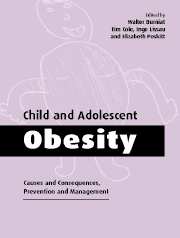Book contents
- Frontmatter
- Contents
- List of contributors
- Foreword
- Preface
- Part I Causes
- 1 Measurement and definition
- 2 Epidemiology
- 3 Molecular and biological factors with emphasis on adipose tissue development
- 4 Nutrition
- 5 Physical Activity
- 6 Psychosocial factors
- Part II Consequences
- Part III Prevention and management
- Index
6 - Psychosocial factors
Published online by Cambridge University Press: 02 November 2009
- Frontmatter
- Contents
- List of contributors
- Foreword
- Preface
- Part I Causes
- 1 Measurement and definition
- 2 Epidemiology
- 3 Molecular and biological factors with emphasis on adipose tissue development
- 4 Nutrition
- 5 Physical Activity
- 6 Psychosocial factors
- Part II Consequences
- Part III Prevention and management
- Index
Summary
With obesity increasing in both adult and child populations, interest in the social context and psychological consequences of obesity has also risen. Accordingly, this chapter will overview some of the social and psychological issues pertinent to childhood obesity. The intention is not to review the topic exhaustively, but to illustrate the depth and complexity of the issues faced by children and their parents today.
Children's social background
One of the richer issues in terms of research publications still, and particularly contentious, is the relationship between obesity and socioeconomic status (SES). It is contentious because of questions of causality and because it is an example of the broader problem of the origins of health inequalities in populations, something of major social and political significance (Power & Matthews, 1997).
Sobal and Stunkard reviewed the literature on obesity and SES (some 144 studies) in 1989. They distinguished between studies conducted in developed and developing countries, those on women and men, and those that included children. Research conducted in developed countries showed that for women there was a strong inverse relationship between SES and obesity, with a higher proportion of obese women in low SES categories. This relationship was much weaker in studies that included girls. Indeed, only 40% of the latter studies showed this negative relationship. A quarter showed a direct positive relationship and a third no relationship at all.
- Type
- Chapter
- Information
- Child and Adolescent ObesityCauses and Consequences, Prevention and Management, pp. 109 - 128Publisher: Cambridge University PressPrint publication year: 2002
- 8
- Cited by



